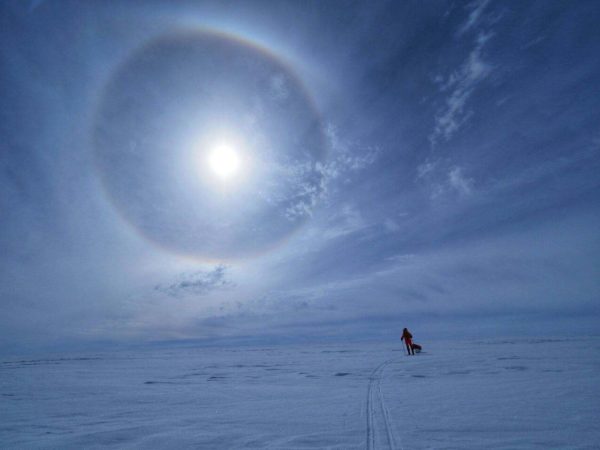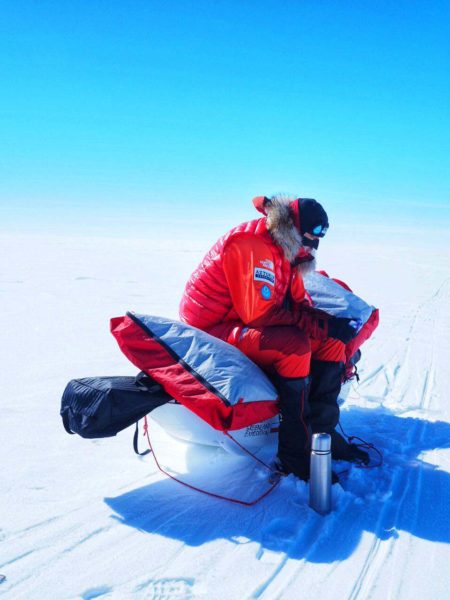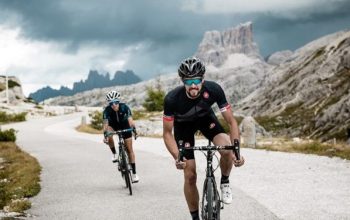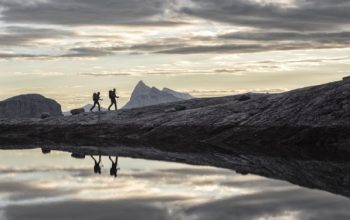Mateusz Waligóra and Łukasz Supergan at the halfway point of the expedition through Greenland
Malfunctions and repairs, an abandoned Cold War radar station, snow blizzards and sunny halos – not a moment of boredom in Greenland. Waligóra i Supergan They already have 300 km in their legs.
The two travelers started their expedition three weeks ago. Behind them half of the route. – We are close to the highest point of the ridge we are moving on. Soon it should be gently downhill – says Lukasz Supergan.
 photo. Mateusz Waligóra / Łukasz Supergan
photo. Mateusz Waligóra / Łukasz Supergan
Together with Mateusz Waligóra they head towards the settlement of Isortoq, located in the east of the world’s largest island. The pools they are pulling behind them are getting lighter – as the food supply, which should last them 30 days, is dwindling. They have to eat at least 5,000 kcal every day.
 fot. Mateusz Waligóra / Łukasz Supergan
fot. Mateusz Waligóra / Łukasz Supergan
Initially they were going at a speed of approx. 10 km per day, now it’s over 20 km. The weather in recent days has been great. The travelers moved on skis under a cloudless sky, admiring the halo phenomenon – the colorful halo around the sun.
 photo. Mateusz Waligóra / Łukasz Supergan
photo. Mateusz Waligóra / Łukasz Supergan
However, there happened to be a day during which they were unable to leave the tent. It was blowing more than 80 km / h, and the world shrank to a few meters – white darkness prevailed further on. – We spent the day in a tent, eating, drinking, recovering. We repaired a broken binding. Unfortunately, we were unable to do anything about my unsealed mattress. So the next nights promise to be colder – says Waligóra, for whom the expedition across the Greenland ice sheet is a general test before the expedition to the South Pole planned for the end of the year.
 fot. Mateusz Waligóra / Łukasz Supergan
fot. Mateusz Waligóra / Łukasz Supergan
In recent days, travelers have reached the abandoned DYE-2 radar station, which was one of the many components of the rapid warning system during the Cold War period. – There are still a lot of things inside that the station crew left behind in a hurry. Completely as if we moved to the past – says Waligóra.
 photo. Mateusz Waligóra / Łukasz Supergan
photo. Mateusz Waligóra / Łukasz Supergan
Marching through Greenland is not just a sporting goal – the travelers are looking at the Arctic in terms of climate change, and they publish information on global warming every day on their social media. The Arctic Ocean, the shallowest and smallest in the world, is changing at a rapid pace. Some forecasts say that in 2040. For the first time in hundreds of thousands of years it may be free of ice. Global warming is progressing in the far North two to three times faster than in other parts of the world. Measurements taken since 1912. In Longyearbyen, the capital of Svalbard, indicate that this place is warming up at a rate of 0.25 deg. Celsius for a decade. The North Pole, which today is a point on ice, may become a point on water in the near future.
 photo. Mateusz Waligóra / Łukasz Supergan
photo. Mateusz Waligóra / Łukasz Supergan
The expedition is formally named Polish Greenland Expedition A-22-750. The last segment is a unique number assigned to the expedition by the Greenland government. Polish Greenland Expedition, in turn, is a reference to the first Polish scientific expedition to the Arctic, which set off 85 years ago from Lviv. It included two later professors of Wroclaw University – Aleksander Kosiba and Alfred Jahn. Scientific and organizational support was given to them by Henryk Arctowski himself, a pioneer of climate change research, a participant in the famous “Belgiki” expedition, during which he and later South Pole conqueror Roald Amundsen spent the winter in the Antarctic ice



